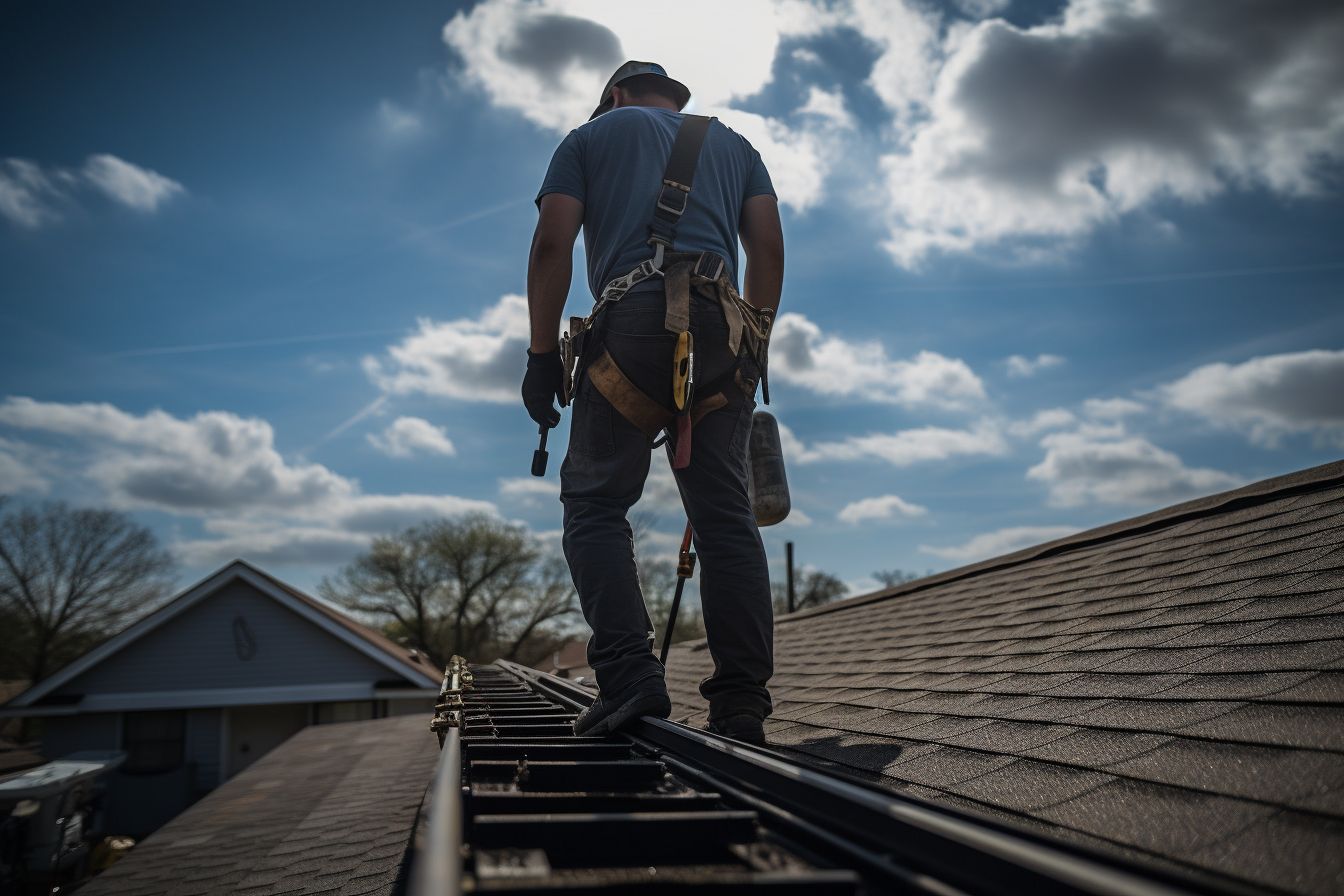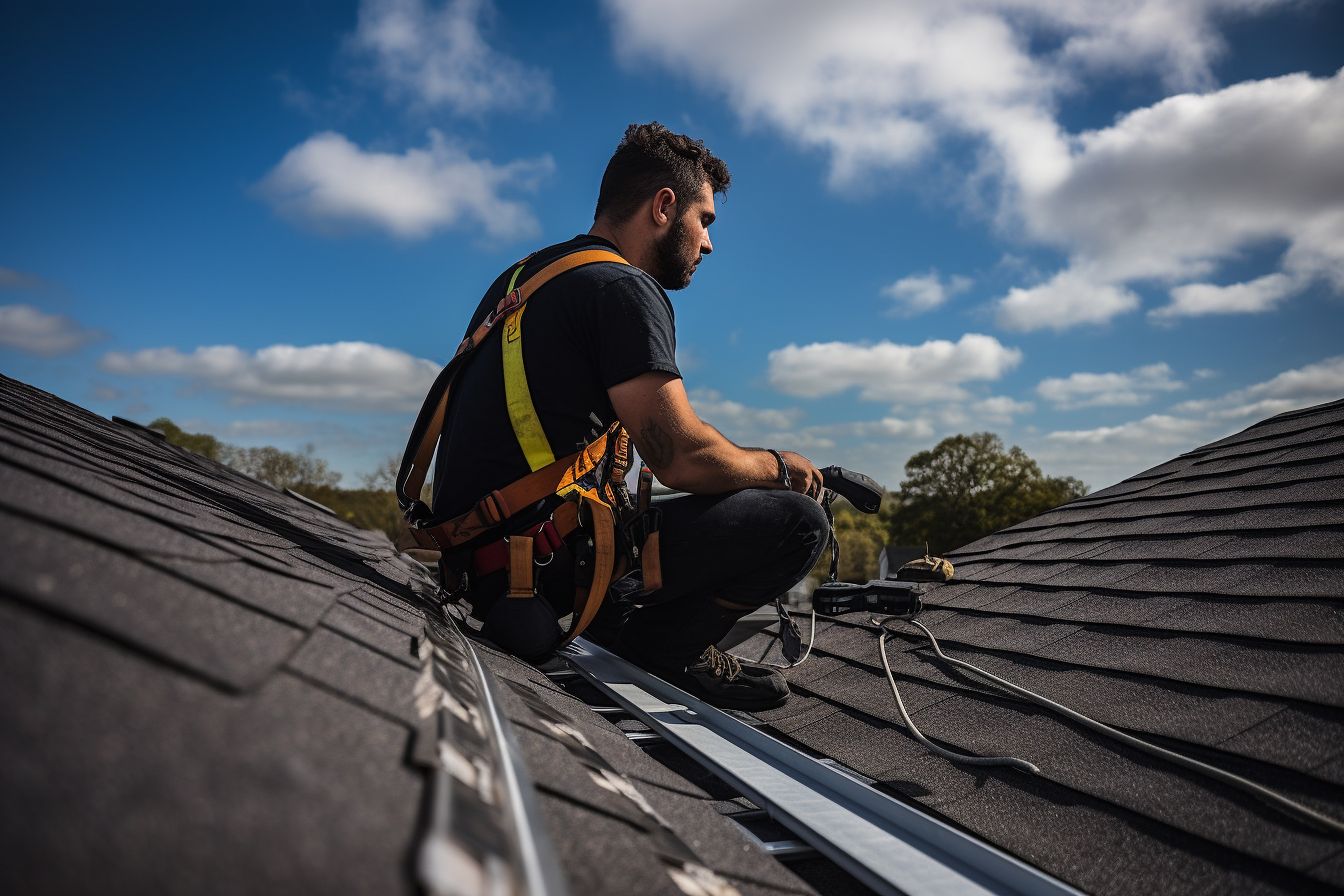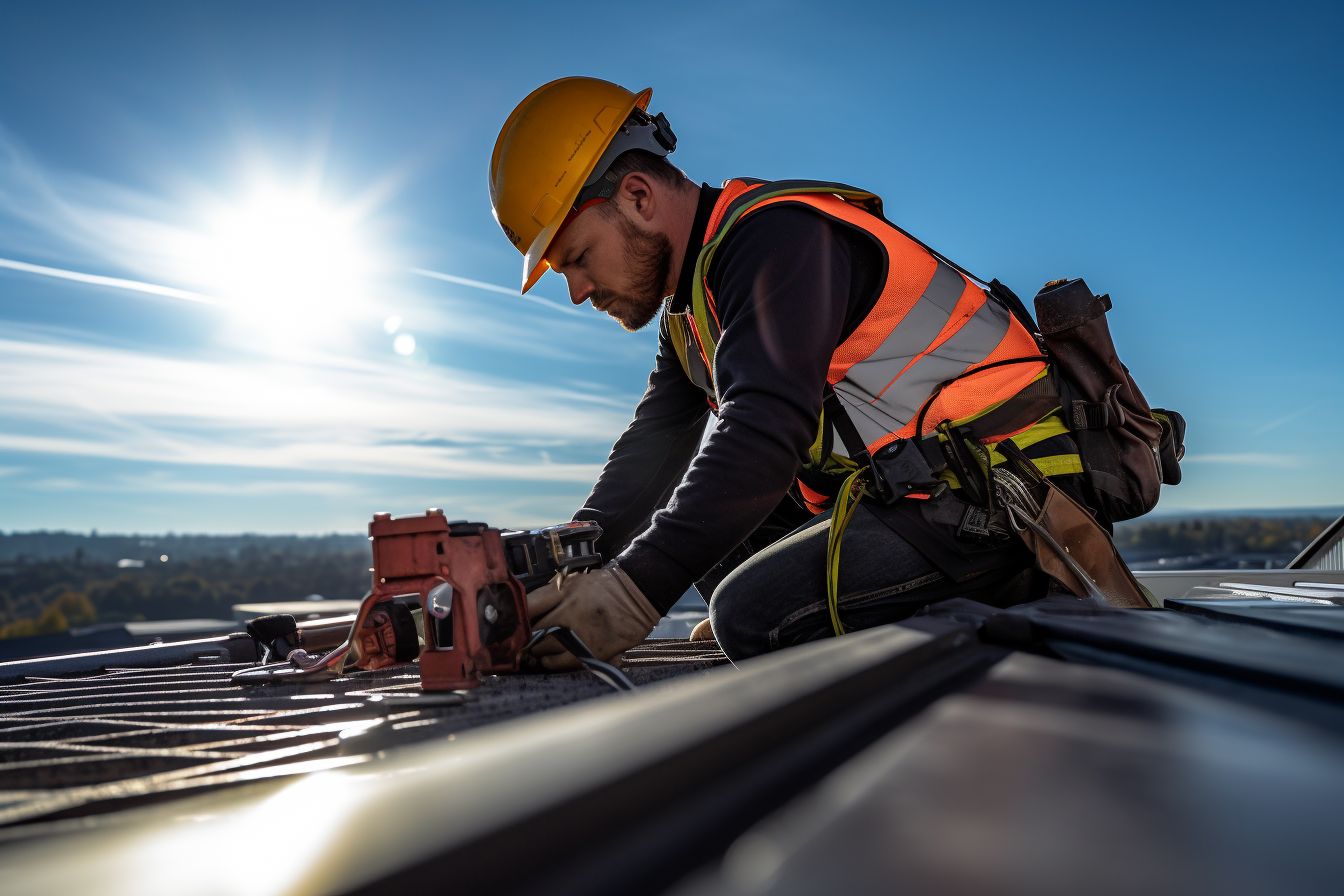Is your home’s sanctuary being jeopardized by a pesky roof leak? Unresolved leaks can lead to costly damages over time. This article will guide you step-by-step on how to patch that annoying leak and secure your roof again.
Read on, and let’s tackle this issue head-on, shall we?
Key Takeaways
- Look for wet spots on the sheathing or rafters to identify a roof leak.
- Check for holes or tears in the flashing, which can cause water damage.
- Remove and replace damaged roof vents to prevent further leaks.
- Tear off old roofing shingles and paper to expose the source of the leak.
How to Find a Roof Leak

To find a roof leak, look for wet spots on the sheathing or rafters and check for holes or tears in the flashing.
Look for Wet Spots on Sheathing or Rafters
Detecting roof leakage often begins with looking for wet spots on sheathing or rafters. Wet spots are clear signs of water penetration, indicating a need for immediate attention.
During routine roof inspections, you can easily spot these shiny or damp areas using a flashlight. It’s crucial to investigate the slightest hint of moisture as it can cause significant damage if not addressed promptly.
Water seeping under shingles tends to rot the roof deck sheathing, leading to soft spots and escalating roofing issues further. To protect your home from severe water damage caused by leakages, actively check and address any detected wet spots on sheathing or rafters during regular maintenance checks.
Check for Holes or Tears in the Flashing
Flashing is a vital part of your roof, engineered specifically to seal areas where the roofing surface has been interrupted. Water damage can be caused by even minor holes or tears in this protective waterproof barrier.
Acts of nature such as strong winds and hailstorms, improper installation, and normal wear over time can lead to these minute yet impactful damages.
To stave off potential leaks, homeowners must regularly check their roof’s flashing. Look for any irregularities or signs of compromise in the material. If you spot any vulnerabilities like holes or tears, immediate action is necessary.
Depending on the size and extent of the damage, solutions may range from applying a waterproof sealant for small issues to replacing large sections if deterioration is advanced. Don’t underestimate the role proper flashing plays in preventing water intrusion – it protects your home from structural harm while helping preserve its exterior aesthetics.
Steps to Fix a Roof Leak
To fix a roof leak, you need to locate the source of the leak, examine and remove any damaged roof vents, tear off old roofing shingles and paper, cut away the damaged roof deck, attach a new roof deck patch, lay paper or underlayment, run the first row of shingles, and complete the shingle installation.
Locate the Roof Leak
Spotting the roof leak is the cornerstone of any effective roof repair strategy. You should begin by looking for signs on your home’s interior, such as ceiling water stains, and then move to inspect your home’s exterior.
Get a ladder and methodically examine each section of your roof, documenting any irregularities or damage. Be meticulous during this process, as leaks often occur in small, hard-to-see places like vent pipes or chimneys but can cause significant interior water damage over time if left unchecked.
This crucial step helps ensure a thorough and complete roof repair, thus contributing significantly to effective roof leak prevention strategies.
Examine Roof Vents
Roof vents are an important component of a roofing system, but they can also be a common cause of roof leaks. To fix a leak, it is crucial to examine the roof vents thoroughly. Check for any cracks or gaps that could allow water to enter.
Damaged vents should be removed and replaced promptly to prevent further water damage. Regularly maintaining the roof vents by caulking or sealing around them can temporarily fix leaks and help prevent future issues.
By carefully examining the roof vents and addressing any problems, you can ensure your roof remains watertight and protected from leaks.
Remove the Damaged Roof Vent
It is important to remove the damaged roof vent to fix a roof leak. This step ensures that moisture or water entering the vent can be stopped effectively. The damaged vent should be removed carefully and replaced with a new one to prevent further leaks.
Removing the damaged material around the roof vent creates an opportunity for a successful repair. Before cutting any new material, measure the area accurately for an exact fit.
Once you have removed and replaced the damaged roof vent, you can proceed with other necessary steps in fixing the roof leak.
Replace Roof Vent
To fix a roof leak, it may be necessary to replace the roof vent. Start by examining the roof vents as a possible source of the leak. Any damaged ones should be removed and replaced with new ones.
Additionally, using caulk around the edges of shingles near the vent can help seal any gaps and prevent further leaks. Don’t forget that replacing the rubber seal around vent pipes can also address this issue effectively.
So check your roof vents when fixing a leak to ensure proper ventilation and prevent future problems.
Tear Off Old Roofing Shingles
Tearing off old roofing shingles is a crucial step in fixing a roof leak. Removing the old shingles allows you to identify any damaged areas causing the leakage easily. This helps prevent further water damage and ensures proper repair.
It’s important to carefully remove the old shingles without causing additional harm to the roof. Once removed, you can replace them with new ones to create a secure waterproof seal.
Tearing off old roofing shingles is a common practice in roof maintenance and is essential for protecting your home from water damage.
Remove the Old Roofing Paper
Removing the old roofing paper is a crucial step in fixing a roof leak. This paper, which may have become damaged or worn over time, must be carefully removed from the wood sheathing.
By doing so, you can effectively identify and address the source of the leak. One option for replacing the old roofing paper is a strip of adhesive ice-and-water barrier. This ensures your roof is properly sealed and protected from further water damage.
Mark the Deck Cut Area
Marking the deck cut area is crucial when fixing a roof leak. This step becomes especially important if there is damage to the roof deck. By marking the area that needs repair, it becomes easier to identify where to make the necessary cuts.
Cutting away the damaged portion of the roof deck is essential in addressing and resolving the leak issue. Removing this section ensures that you have a clean and stable surface to perform repairs.
It allows for proper waterproofing and helps maintain the structural integrity of your roofing system.
Cut Away the Damaged Roof Deck
Cutting away the damaged roof deck is crucial in fixing a roof leak. This allows you to assess if the substrate has been affected by water damage. By removing the damaged section of the roof deck, you can then replace it using a new piece that matches the dimensions of the cut area.
This replacement piece can be securely fastened into place using screws, ensuring that it creates a sturdy and watertight seal. The cost of this repair may vary depending on the extent of the damage and the materials needed for the replacement.
Remove Roof Deck
One crucial step to fix a leaking roof is to remove the roof deck. This involves tearing off the old roofing shingles and removing the old roofing paper to expose the wood sheathing underneath.
Removing these damaged layers can create a clean surface for repairs. Removing the roof deck also allows you to inspect it for any further damage or rot that may need attention before fixing the leak.
Once removed, you can cut and attach a new roof deck patch as part of the overall repair process. Properly removing and replacing the roof deck is essential in ensuring a long-lasting solution to your leaking roof problem.
Cut New Roof Deck Patch
One important step to fix a leaky roof is cutting a new roof deck patch. This patch is used when damage to the roof deck is causing the leak. The damaged area of the deck is cut away, and then a new piece of roofing material is put in its place.
This replacement piece helps restore the roof’s structural integrity and prevent further water damage. Inspecting the roof and locating the exact spot of the leak before starting this repair is crucial.
By addressing issues promptly, you can minimize damage to your building’s structure and interior.
Attach the Roof Deck Patch
To fix a roof leak, attaching the roof deck patch is a crucial step. After inspecting and replacing damaged caulk or cracked siding, you can create the patch using plywood or shingles.
Apply roofing tar to seal it properly. Slip the roof flashing underneath the shingle where the hole is located and secure it with a bead. Before attaching the patch, remove any misplaced roofing repair nails for a smooth installation process.
Following these steps can effectively stop water from entering your home through the roof leak.
Lay Paper or Underlayment
Laying paper or underlayment is a crucial step in fixing a roof leak. It involves securely nailing down the roofing paper or underlayment using roofing nails. Properly overlapping each row by at least 4 inches ensures thorough coverage and protection against leaks.
The underlayment is an additional barrier for minor roof leaks around penetrations and safeguards against water infiltration. When damage to the roof’s sheathing, it must be replaced along with the shingles and underlayment for a long-lasting solution to prevent future leaks.
Run the First Row of Shingles
To fix a roof leak, running the first row of shingles is essential. This step is crucial in preventing further damage and stopping the leak. By laying down the initial row of shingles properly, you can create a barrier against water infiltration and ensure that your roof remains watertight.
Running the first row of shingles is integral to repairing a roof leak and should not be overlooked. It helps to protect your home from water damage and maintain the integrity of your roofing system for years to come.
Complete the Shingles
After removing the damaged shingles and assessing evidence of leaks, it is time to complete the shingles. This involves installing the replacement shingles in the appropriate size and pattern.
Measuring the damaged area accurately is important to ensure a proper fit for the new shingles. By following this step, you can restore your roof’s integrity and protect your home from further water damage.
Detailed Guide on How to Fix a Roof Leak

To fix a roof leak, following a detailed guide that provides step-by-step instructions is important. First, identify the leak’s location by looking for wet spots on the sheathing or rafters and checking for holes or tears in the flashing.
Once you’ve located the leak, examine any roof vents in the area and remove any damaged ones. Replace them with new ones to ensure proper ventilation.
Next, it’s time to repair the roofing materials themselves. Start by tearing off old shingles and removing any old roofing paper. Mark the area where you need to cut away damaged roof deck sections and carefully remove those sections.
Cut a new patch for the deck and attach it securely.
After repairing or replacing the deck, lay down paper or underlayment to protect against leaks. Then, run your first row of shingles along one edge of your roof and complete laying down all rows until you reach your desired coverage.
By following this detailed guide, you can effectively fix a roof leak yourself without needing professional help in many cases. Remember to take necessary safety precautions when working at heights!
When to Call a Professional

It is important to know when to call a professional roofer for assistance with fixing a roof leak. Here are some situations where it may be best to seek professional help:
– Complex roof issues that require specialized knowledge and equipment
– Roof leaks occurring during heavy rain or severe weather conditions
– Water leaks in the ceiling, indicating potential damage that needs expert assessment
– When DIY attempts have not successfully resolved the problem
– To prevent further damage and costlier repairs
Leaving a leaking roof unattended for too long can lead to more extensive damage, so contacting a professional at the right time is crucial.
Conclusion
In conclusion, fixing a roof leak requires careful inspection and proactive steps. You can successfully repair a leaking roof by locating the leak, examining roof vents, replacing damaged components, and properly installing new materials.
Remember to address any underlying issues causing the leak, such as damaged flashing or worn-out roofing shingles. With patience and attention to detail, you can ensure a watertight and secure roof for your home.
FAQs
1. How can I identify a roof leak?
You can identify a roof leak by looking for water stains on the ceiling, peeling paint or wallpaper, mould or mildew growth, or damp spots around light fixtures.
2. What are some temporary solutions to fix a roof leak?
Temporary solutions to fix a roof leak include using roofing cement to seal small cracks or applying a tarp over the damaged area until permanent repairs can be made.
3. Can I repair a roof leak myself?
Reproducing a minor roof leak is possible if you have basic roofing knowledge and safety precautions. However, consulting with a professional roofer for more complex leaks is recommended.
4. When should I contact a professional roofer?
You should contact a professional roofer when you cannot locate the leak’s source, when the damage is extensive or beyond your skill level or if you want long-lasting repairs done correctly.
5. How much does it cost to fix a roof leak?
The cost of fixing a roof leak varies depending on factors such as the extent of damage, type of roofing material, and location. Getting an estimate from multiple reputable contractors in your area is best.

